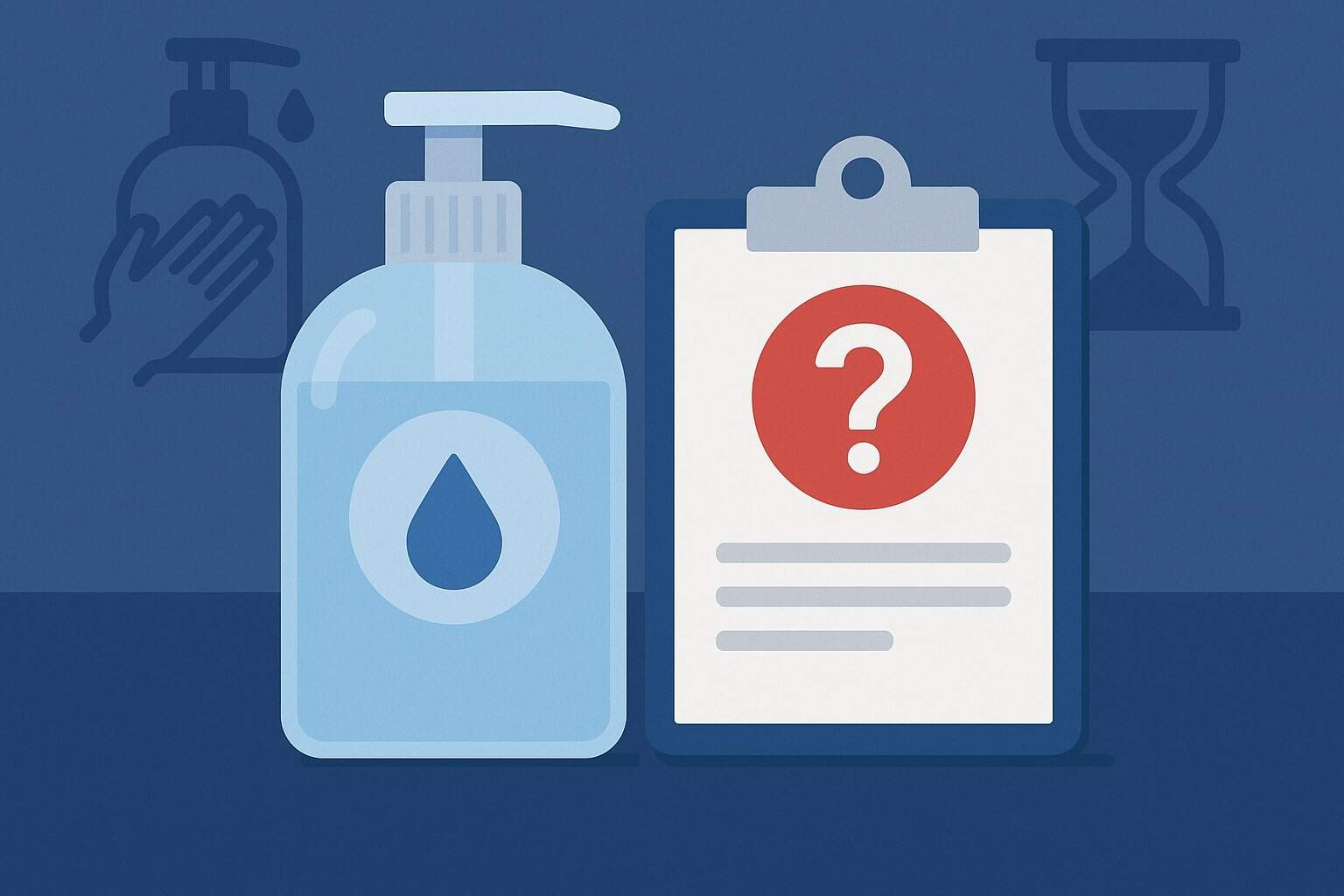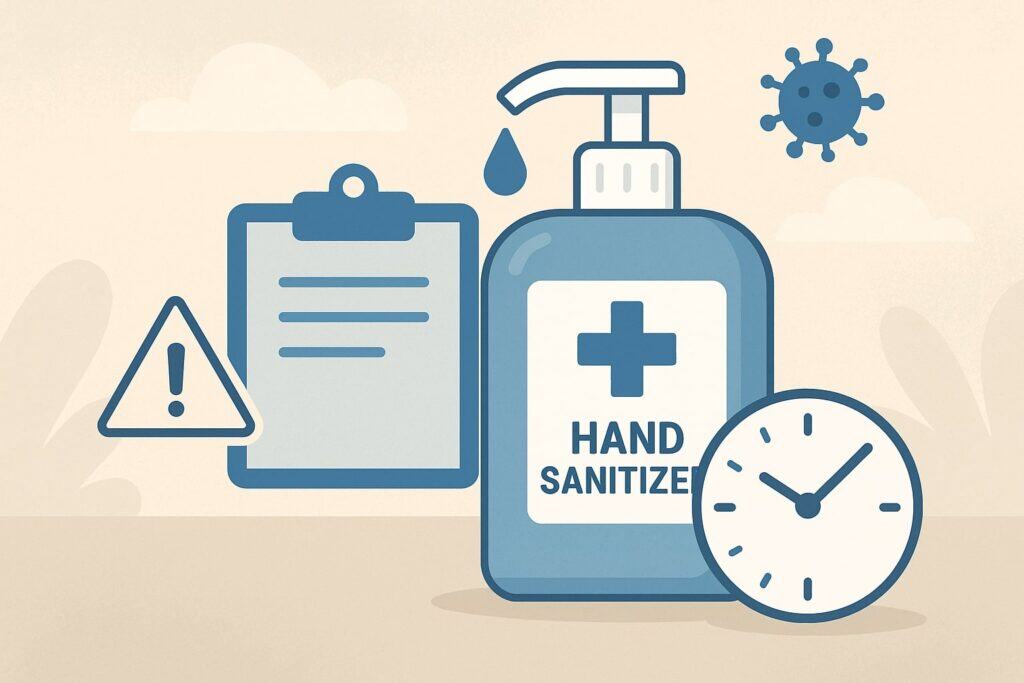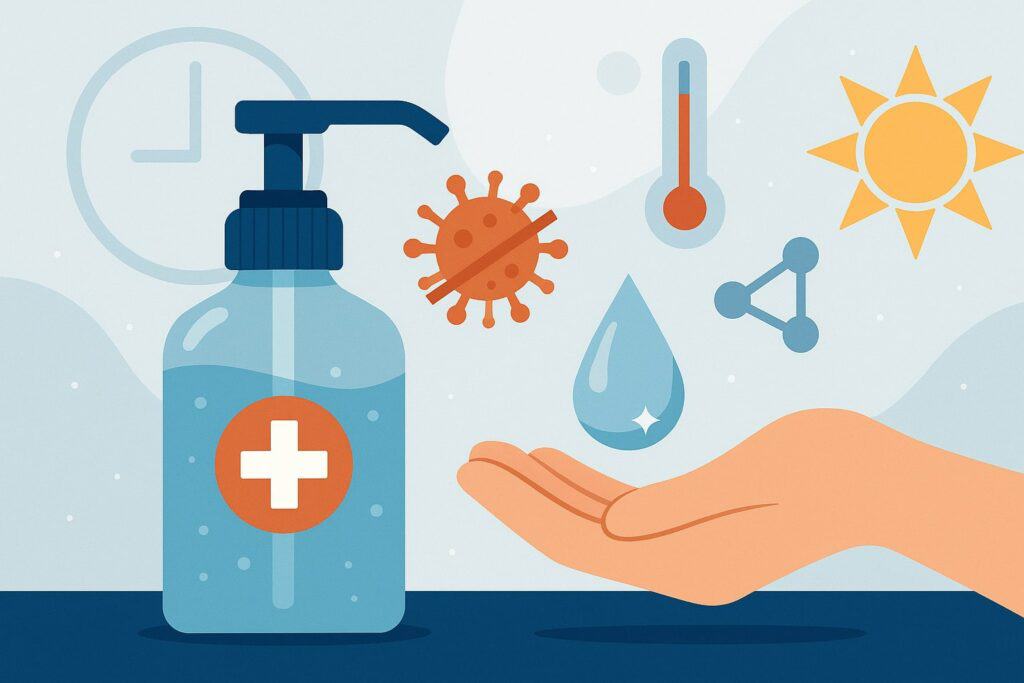
By myhandsanitizershop October 16, 2025
Hand sanitizer has become a household essential, especially in the United States where everyday use—from travel to public spaces—is routine. But can hand sanitizer expire? And if so, how quickly does it lose effectiveness?
In this in-depth guide, we’ll explore the science behind expiration, how long hand sanitizer typically remains viable, the factors that influence its shelf life, how to tell if it’s gone bad, how to store it properly, and best practices for disposal.
By the end, you’ll understand exactly when to replace your sanitizer and how to ensure you’re getting its full germ-killing benefit.
What Does “Expiration” Really Mean for Hand Sanitizer

When you see an expiration date on a bottle of hand sanitizer, it might seem like a legal formality—but it actually serves a specific purpose. Under U.S. regulations, many hand sanitizers are classified as over-the-counter (OTC) antiseptic products and are regulated by the Food and Drug Administration (FDA).
In that context, manufacturers must demonstrate, through stability testing, that their product retains a defined level of potency, purity, and safety up until the expiration date.
Regulatory Basis and Stability Testing
To justify an expiration date, a manufacturer performs stability studies. These are laboratory tests that store the product under various conditions (e.g., controlled temperature, accelerated aging) and periodically measure the concentration of active ingredients (such as ethyl alcohol or isopropyl alcohol).
As long as the product retains a sufficient proportion—commonly no less than 90% of the labeled strength—the product is considered effective. Once it falls below that threshold, it is considered “expired.”
Thus, an expiration date is not an absolute “switch” where the product becomes dangerous overnight; rather, it is a benchmark signifying when the manufacturer can no longer guarantee full performance.
What Expiration Does and Does Not Imply
- Does mean that the hand sanitizer may begin to lose potency, i.e., the percentage of active ingredients (alcohol or antiseptic) may drop.
- Does not mean the product becomes harmful or immediately ineffective. In many cases, slightly expired hand sanitizer will still kill germs, just less reliably.
- Does mean that once the active ingredient drops below a threshold (typically 60% alcohol, for alcohol-based sanitizers), it may fail to inactivate or kill some viruses or bacteria effectively.
- Does not mean you must discard every bottle the moment the date passes—especially if the product has been stored well and shows no signs of degradation.
In short, the expiration date is a conservative estimate to ensure safety and efficacy. Use it as a guideline, but also consider signs of decline in condition when evaluating continued use.
Why and How Hand Sanitizer Loses Potency

To understand expiration, one must understand why hand sanitizer deteriorates over time. The key factors lie in its chemical composition and physical behavior.
Primary Active Ingredients and Their Vulnerabilities
Most hand sanitizers in the U.S. are alcohol-based, using ethanol (ethyl alcohol) or isopropyl alcohol as the active germ-killing agent. Some non-alcohol sanitizers use agents such as benzalkonium chloride (BAC), but these are less common and have different stability considerations.
- Volatility of alcohol: Alcohol is a volatile compound, meaning it readily evaporates when exposed to air or heat. Over time, even sealed containers may allow tiny amounts of evaporation or permeation, which gradually reduces the concentration of alcohol.
- Physical changes: Some sanitizers contain humectants (e.g. glycerol, moisturizing agents), thickeners, or water. As the proportion of alcohol drifts downward, the fluid may become more viscous or “gloopy,” altering how it spreads and evaporates on the skin.
- Chemical degradation: While alcohol itself doesn’t “go bad” in the typical sense, other ingredients (like hydrogen peroxide, which is sometimes included in formulations) can degrade to water over time, slightly diluting or altering the formulation.
Factors Accelerating Degradation
Several external factors can speed up the decline:
- Temperature: Higher temperatures increase evaporation rates and can hasten chemical breakdown. A bottle stored in a hot car or near heat sources may lose potency faster.
- Light exposure: Some formulas may be subject to photodegradation, especially if packaging is clear and allows UV light to penetrate.
- Container integrity: Imperfect seals or packaging permeable to air can cause slow loss of alcohol over time.
- Frequent opening: Each time a bottle is opened and used, there is exposure to air, which can slightly reduce alcohol content cumulatively.
- Partial fill: A near-empty bottle has more headspace (air volume) relative to product volume, potentially worsening evaporation losses.
Effect on Antimicrobial Efficacy
As alcohol concentration drops, the sanitizer’s ability to inactivate viruses, bacteria, and other pathogens diminishes. The Centers for Disease Control and Prevention (CDC) recommends using hand sanitizers with at least 60% alcohol content for adequate disinfection. If the concentration falls below that threshold, some germs may survive.
A review of pathogen susceptibility found that, for many viruses (including coronaviruses, influenza, etc.), ethanol concentrations of around 42–50% still had some activity, though much weaker. But these lower concentrations may not reliably offer protection, especially under real-world conditions (e.g. short contact time, heavy contamination).
Thus, the gradual loss of alcohol transforms “effective” sanitizer into a less dependable antiseptic over time.
Typical Shelf Life: How Long Does Hand Sanitizer Last?

Given the regulatory and chemical considerations above, what is a realistic shelf life for hand sanitizer in the U.S.?
Common Expiry Duration
- Many manufacturers set expiration dates of 3 to 5 years from the manufacturing date. For example, GOJO (maker of PURELL) often prints a shelf life of 5 years under ideal storage conditions.
- Some hand sanitizers may carry shorter expiration periods—2 to 3 years—depending on the stability of the formula and packaging.
- During the COVID-19 pandemic, many emergency-produced sanitizers lacked long-term stability studies and thus may not have reliable or printed expiration dates.
Thus, a general expectation is 2 to 5 years of shelf life when stored properly.
Unopened vs. Opened Bottles
- Unopened bottles that remain sealed in ideal storage (cool, dark, dry) are most likely to achieve or exceed their labeled shelf life. The closed system minimizes evaporation and exposure.
- Opened or partially used bottles may degrade more rapidly due to repeated exposure to air, temperature fluctuations, and possible contamination.
Real-World Reports & Studies
Institutions often weigh in on real-world performance:
- The University of Southern California’s Environmental Health and Safety states expired hand sanitizers may still kill germs, but their alcohol content could decline, especially if storage was poor.
- The University’s guidance also notes that manufacturers print expiration dates to indicate when the product reaches 90% of its original effectiveness.
- Laboratories like Lawrence Berkeley have observed that if the sanitizer still smells strongly of alcohol and evaporates quickly, it may still function acceptably even beyond its expiration.
- Environmental Health & Safety resources note that hand sanitizer is safe to use beyond the expiration date if conditions are good, though efficacy may be reduced.
These real-world perspectives align with the scientific basis: the “expiration” is conservative and performance loss is gradual, not abrupt.
How to Tell if Hand Sanitizer Is Still Good
You may find you have older sanitizer on hand—how do you assess whether it’s still functional? Here are signs and tests to evaluate its condition.
Sensory Clues & Physical Indicators
- Smell of alcohol: A strong, crisp smell of alcohol (ethanol or isopropyl) is a good sign the active ingredient remains in decent concentration. A faint or almost absent alcoholic aroma may suggest alcohol loss.
- Viscosity or texture changes: If the sanitizer becomes noticeably thicker, “gloopy,” or gelled, it may indicate changes in balance of ingredients. It should still flow and spread reasonably well.
- Evaporation behavior: Apply a small amount to your palm and rub. A fresh sanitizer will evaporate rather quickly (in 15–30 seconds, depending on amount). If it lingers wet or sticky for a long time, that may signal reduced alcohol.
- Visual clarity and separation: Check for separation, cloudiness, or discoloration. These could indicate ingredient instability or contamination.
Simple At-Home Test (Semi-Qualitative)
You can do a rough “waft test”:
- Place a small drop on a surface (e.g. glass or plastic sheet).
- Waft your hand above it (don’t sniff directly).
- If the smell is strong and noticeable, that suggests decent alcohol content. If it’s weak or absent, potency may have dropped.
This is not precise, but it gives a heuristic sense.
When to Discard It
- If the product has no alcohol smell
- If it has changed texture severely or separated
- If it no longer evaporates within a short period
- If it’s well past its expiration date and storage has been suboptimal
- If unknown production origin (e.g. pandemic-era sanitizer without expiration date)
- If bottle is damaged or contaminated
In these cases, it’s safer to replace the sanitizer with a fresh, certified product.
Alcohol-Based vs. Alcohol-Free Sanitizers: Are Expiration Factors the Same?
Not all sanitizers are alcohol-based. Some use alternative antiseptic compounds (most commonly benzalkonium chloride, or BAC). Their stability and expiration behavior differ somewhat.
Alcohol-Based Sanitizers
- Depend on volatile alcohol (ethanol or isopropanol) as the active germ-killing agent.
- Their main vulnerability is loss of alcohol over time through evaporation or permeation.
- Expiration tends to be 2–5 years, with performance weakening gradually.
Alcohol-Free (BAC or Other Antiseptics)
- Use quaternary ammonium compounds like benzalkonium chloride or other antimicrobial agents.
- These do not evaporate like alcohol, so their degradation is more chemical (e.g. breakdown of active agent, interaction with other ingredients).
- The shelf life is often determined by how the antimicrobial compound and carrier formula hold up.
- Expiration for these products may also be in the range of 2–3 years depending on formulation and preservatives.
- One caveat: some non-alcohol sanitizers are less broadly effective (especially against certain viruses) to begin with, so any degradation may have a more significant relative impact.
While both types degrade, alcohol-based sanitizers tend to show more predictable and observable decline because alcohol loss is tangible (smell, evaporation).
In practice, most U.S. hygiene guidelines prioritize alcohol-based sanitizers with at least 60% alcohol, so much of the attention is on those.
If you use alcohol-free products, check expiration dates and manufacturer stability data carefully.
Proper Storage to Maximize Shelf Life
Even a high-quality hand sanitizer can degrade prematurely if stored poorly. Good storage practices help ensure you extract full utility from your product.
Ideal Storage Conditions
- Cool temperatures (room temperature or slightly below, typically 15–25 °C / 59–77 °F)
- Avoid heat — do not store in direct sunlight, near radiators, heaters, inside a hot car, or near engines
- Avoid freezing and extreme cold fluctuations
- Opaque or UV-blocking containers (if possible) to prevent photodegradation
- Tight, airtight seals to reduce evaporation
- Minimal headspace (less empty volume in partially used bottles)
- Dry, low-humidity environment
Places to Avoid
- Inside vehicles on hot days
- On windowsills exposed to sun
- Near heat sources (ovens, stoves, heaters)
- Outdoors uncontrolled
- Damp or humid storage rooms
Tips to Improve Longevity
- Use smaller bottles if you won’t finish a large one quickly
- Transfer to opaque or dark bottles if original is clear (but ensure safe material compatibility)
- Keep in original closed container
- Use it within a reasonable time frame rather than long-term storage
- Rotate stock like perishable goods—use older bottles first
Many hand sanitizers specify “store at controlled room temperature” which generally aligns with these practices.
Is Expired Hand Sanitizer Still Safe or Harmful?
One concern many people have is safety: is it harmful to use expired hand sanitizer, or simply less effective? The evidence indicates that expired sanitizer is typically not dangerous, but it may be less reliable in germ-killing.
Safety Considerations
- Toxic degradation: Alcohol-based sanitizers, if degraded, mostly lose potency; they don’t usually form toxic byproducts under normal conditions.
- Contamination risk: Older or compromised containers might have microbial contamination or impurity ingress, particularly if opened or stored poorly.
- Skin irritation: If the formula’s balance is disturbed, perhaps by ingredient breakdown, it might irritate sensitive skin.
- Flammability: Alcohol-based sanitizers remain flammable even if somewhat degraded, so they must still be handled cautiously.
Multiple expert resources and universities note that expired sanitizers are not inherently harmful:
- The University of Southern California says expired sanitizers are safe to use, as long as strength hasn’t dropped excessively.
- Safety documents from universities like Oklahoma State note that expired sanitizer is “safe to use” if it smells and performs well.
- Lawrence Berkeley Lab says many expired hand sanitizers are fine if they still evaporate quickly and smell strongly of alcohol.
So while the safety risk is minimal, the performance risk is real: an ineffective sanitizer may give you a false sense of protection against germs.
Therefore, the practical advice is: if in doubt, replace it.
When and How to Dispose of Expired Hand Sanitizer
Because hand sanitizer is often a flammable or regulated liquid (especially alcohol-based), proper disposal matters.
Regulatory & Safety Concerns
- Alcohol-based sanitizers are considered flammable liquids. Discarding in normal trash or pouring down drains may pose fire or vapor hazards.
- Many municipalities treat them under household hazardous waste (HHW) protocols.
Safe Disposal Steps
- Check local regulations: Many U.S. cities have HHW drop-off or collection events.
- Don’t mix with incompatible chemicals: Avoid dumping into bleach, acids, or other strong chemicals.
- Use small amounts up: If only a little remains and it still works, use it rather than dispose.
- Seal and recycle container if possible: If the container is recyclable and empty, rinse (if safe) and recycle per local rules.
- Avoid pouring into drains or trash: Flammable vapors or liquids can damage plumbing or create hazards.
By following these steps, you can discard expired sanitizer safely and responsibly.
Best Practices for Users: How to Maximize Effectiveness
To get the best out of your hand sanitizer, avoid pitfalls that reduce efficacy:
- Use an alcohol-based product with at least 60% concentration
- Apply enough volume to fully cover all hand surfaces (front, back, between fingers)
- Rub for 20 seconds or until dry — don’t wipe off early
- Don’t store near heat
- Monitor expiration dates
- Replace old or weakened bottles
- Prefer soap and water when hands are visibly dirty
- Carry a travel-size bottle and rotate usage of stock in home
By combining good storage and usage habits, you’ll ensure your sanitizer remains as effective as possible.
Frequently Asked Questions (FAQs)
Q1: Does hand sanitizer really expire like food?
Answer: Not in the same way. Expiration for hand sanitizer refers to when it may lose sufficient potency—not spoil or rot. It does not typically become hazardous after expiry, but may be less effective.
Q2: Is it safe to use hand sanitizer past the expiration date?
Answer: Generally yes—if it still smells strongly of alcohol, flows well, and evaporates quickly, it’s likely still serviceable. But its germ-killing ability may be reduced.
Q3: How long does unopened hand sanitizer last?
Answer: Typically 2 to 5 years, depending on the brand, formula, and storage conditions. Many manufacturers label 3 to 5 years.
Q4: How long does an opened sanitizer last?
Answer: That depends on usage patterns and storage. Frequent opening, high temperatures, and evaporation can shorten effective life. You may want to replace it sooner than an unopened one.
Q5: Can I test my alcohol percentage at home?
Answer: Not precisely without lab equipment. The sensory smoke/smell/evaporation test is rough but useful. For exact measurement, lab titration is required.
Q6: What if my bottle has no expiration date?
Answer: Check the lot code and contact the manufacturer. If no reliable data is available or it’s old, it’s safer to replace.
Q7: Does hand sanitizer kill all germs?
Answer: No. It works best against many viruses and bacteria but is less reliable against certain pathogens (e.g., C. difficile, norovirus). Washing with soap and water is preferred when possible.
Conclusion
Hand sanitizer does expire, but that does not mean it suddenly becomes harmful or useless. The expiration date reflects the timeframe during which the manufacturer can confirm its performance. Over time, evaporation and chemical changes can reduce the concentration of active ingredients—especially alcohol—making the sanitizer less effective.
In the U.S., common shelf life durations are 2 to 5 years when stored optimally. Unopened bottles tend to fare better than opened ones, and proper storage in cool, dry, dark conditions can prolong usability. You can often tell if a sanitizer is still serviceable by smell, texture, and evaporation behavior.
Expired sanitizer is not usually dangerous, but if in doubt, replace it. Dispose of it responsibly—avoid pouring it into drains or trash, and use household hazardous waste programs when available.